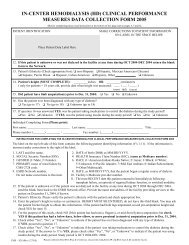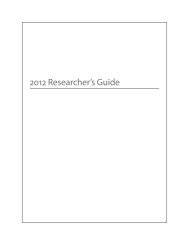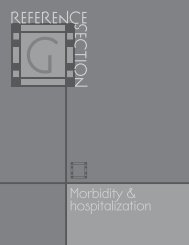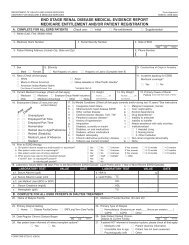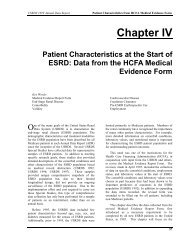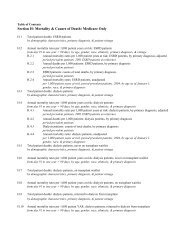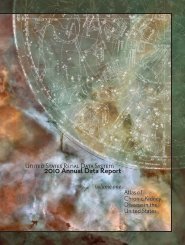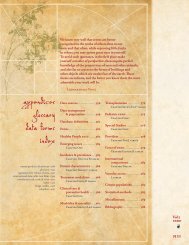Download - United States Renal Data System
Download - United States Renal Data System
Download - United States Renal Data System
Create successful ePaper yourself
Turn your PDF publications into a flip-book with our unique Google optimized e-Paper software.
Establishment of a universal patient identification system was<br />
critical to ensure that unique patient identification numbers<br />
are assigned to each ESRD patient at the time of ESRD initiation,<br />
to accurately track counts and rates of incident and<br />
prevalent cohorts over time.<br />
In 1994, the USRDS CC introduced the Standard Analysis<br />
Files (SAFs)—not to be confused with the CMS Standard<br />
Analytical Files for Part A and Part B claims data—to help<br />
meet the ESRD data needs of a wide variety of research studies.<br />
These SAFs have subsequently been enhanced to include<br />
not only ESRD clinical and claims data from CMS, but also<br />
transplant and wait list data from UNOS. All SAFs are sorted<br />
by the unique USRDS-specified patient identification number,<br />
and patient identifiers (name, address, SSN, HIC/BIC, etc.) are<br />
removed to protect patient confidentiality.<br />
The CC also uses the USRDS ESRD database to generate<br />
the data sets for the tables, graphs, and maps in the USRDS<br />
ADR.<br />
The USRDS ESRD database is updated regularly with data<br />
obtained from the various data sources. The CC generally<br />
receives CMS SAF claims data, Facility Survey data, CDC<br />
Survey data, and UNOS transplant and wait-list data once<br />
a year, and REBUS and EDB data more frequently. These<br />
multiple updates allow the CC to assess growth of the ESRD<br />
population, the demographic distribution of ESRD patients,<br />
and changes in the percent of patients diagnosed with major<br />
diseases secondary to ESRD.<br />
Section 2 · ESRD Patients<br />
ESRD is defined as chronic renal failure requiring renal replacement<br />
treatment—dialysis or transplant—to sustain life.<br />
It is not the same as acute renal failure, from which patients<br />
are expected to recover within weeks or months. A Medical<br />
Evidence Report must be completed immediately by renal<br />
providers for all ESRD patients to register them in the CMS<br />
ESRD database and to apply for Medicare eligibility if they<br />
were not previously eligible.<br />
<strong>Data</strong> Sources<br />
To establish the incident and prevalent cohorts by year,<br />
modality, primary cause of renal failure, and other factors,<br />
patient demographic and clinical information are required<br />
as well as treatment history data. This information can be<br />
obtained from the USRDS Core CD with files “PATIENTS,”<br />
“MEDEVID,” “RXHIST,” “RXHIST60,” and “PAYHIST.”<br />
First ESRD Service Date<br />
The first ESRD service date (FSD) is the single most important<br />
data element in the USRDS database, and each patient<br />
must, at a minimum, have a valid FSD. This date is used to<br />
determine each new patient’s incident year and the first year<br />
in which the patient is counted as prevalent. The date 90 days<br />
after the FSD is used as the starting point for most patient<br />
survival outcomes analyses. This rule allows each new ESRD<br />
patient to generate Medicare services despite potential delays<br />
in completing the Medicare eligibility application process,<br />
and it provides an adequate time period for patients to arrive<br />
at a stable and suitable dialytic treatment modality.<br />
The FSD is derived by taking the earliest of:<br />
♦ the date of the start of dialysis for chronic renal failure,<br />
as reported on the Medical Evidence report,<br />
♦ the date of a kidney transplant, as reported on a CMS or<br />
UNOS transplant form, a Medical Evidence report, or a<br />
hospital inpatient claim, or<br />
♦ the date of the first Medicare dialysis claim.<br />
Most FSDs are derived from the Medical Evidence Report.<br />
In the absence of this form, the date of the first Medicare dialysis<br />
claim or transplantation usually supplies the FSD. In the<br />
few cases in which the date of the earliest dialysis claim is earlier<br />
than the first dialysis date reported on the Medical Evidence<br />
Report, the earliest claim date is used as the FSD.<br />
Identifying ESRD Patients<br />
A person is identified as having ESRD when a physician<br />
certifies the disease on a Medical Evidence Report (CMS<br />
2728), or if other evidence demonstrates receipt of chronic<br />
dialysis or a kidney transplant. Patients who experience<br />
acute renal failure and are on dialysis for days or weeks, but<br />
who subsequently recover kidney function, are, as much as<br />
possible, excluded from the database. Patients who die soon<br />
after kidney failure without receiving dialysis treatment are<br />
occasionally missed.<br />
Incidence and Prevalence<br />
Incidence is defined as the number of people in a population<br />
newly diagnosed with a disease in a given time period,<br />
typically a year. Prevalence is the number of people in a<br />
population who have the disease at a given point in time<br />
(point prevalence) or during a given time period (period<br />
prevalence). The USRDS generally reports point prevalence,<br />
used primarily throughout the ADR, as of December 31,<br />
and period prevalence for a calendar year. Annual period<br />
prevalent data thus incljude people who have the disease at<br />
the end of the year and those who had the disease during the<br />
year and died before the year’s end. Please refer to Getting<br />
Started, page 7, for further details on defining incident and<br />
prevalent patient cohorts using the USRDS SAFs.<br />
The USRDS treats successful transplantation as a therapy<br />
rather than as recovery from ESRD. Patients transplanted at<br />
the time of ESRD initiation are counted as incident patients,<br />
and those with functioning transplants as prevalent.<br />
Because data are available only for patients whose ESRD<br />
therapy is reported to CMS, patients who die of ESRD before<br />
receiving treatment or whose therapy is not reported to CMS<br />
are not included in the database. The terms incidence and<br />
prevalence are thus qualified as incidence and prevalence of<br />
reported ESRD. Some ESRD registries, such as the European<br />
Dialysis and Transplantation Association, use the term “acceptance<br />
into ESRD therapy.” The USRDS, however, believes that<br />
“incidence of reported ESRD therapy” is more precise, because<br />
“acceptance” implies that remaining patients are rejected, when<br />
in fact they may simply not be identified as ESRD cases or may<br />
not be reported to CMS.<br />
Point prevalence is a useful measure for public health research<br />
because it measures the current burden of the disease<br />
22 e Sections 1-9




